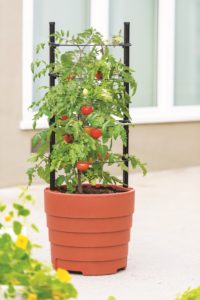 Nothing is more frustrating than investing time, money and energy in planting and growing tomatoes only to watch them succumb to disease. We can’t change the weather conditions that support disease problems, but we can tweak our growing strategies to reduce this risk.
Nothing is more frustrating than investing time, money and energy in planting and growing tomatoes only to watch them succumb to disease. We can’t change the weather conditions that support disease problems, but we can tweak our growing strategies to reduce this risk.
Select and grow the most disease-resistant varieties suited to your growing region. Consult your local University Extension Office for a list of recommended tomatoes and always check the plant tags before purchasing plants.
Plant tomatoes in a sunny location, that receives at least eight or more hours of sunlight, with rich well-drained soil. Your plants will be healthier and better able to fend off insects and tolerate disease.
No room – no problem. Grow your tomatoes in containers filled with a quality potting mix and drainage holes. Many of the newer containers are designed to increase success with less effort on your part. Look for containers with built-in trellises, large reservoirs and other features that promote healthy growth and productivity.
Properly space plants to increase airflow and sunlight reaching all parts of the plant. This reduces the risk of disease and increases a plant’s ability to produce more fruit. Leaving space between plants also helps reduce the spread of disease from diseased plants to nearby healthy plants.
Further reduce the risk of disease by lifting the plants off the ground. Supporting plants with strong tomato cages improves air flow and light penetration while keeping the plants and fruit off the ground and away from soil-borne insects and diseases.
Avoid flimsy tomato towers that tend to topple and bulky cages that consume too much storage space. Consider investing in one of the stronger supports that stores flat and is strong, but flexible to encourage stouter growth. Another benefit is that it opens, so you can easily place them around larger plants; just in case you waited too long to set the cages in place.
Use soaker hoses or irrigation systems that target water to the soil around the plant. Placing water just where it is needed – on the soil – conserves moisture while keeping the foliage dry. Overhead irrigation uses more water and increases the risk and spread of many common tomato diseases.
Boost your tomato plants’ productivity by as much as 20% with red mulch. The USDA and Clemson University developed a red mulch that reflects far-red wavelengths upward into the plants stimulating growth and development.
Rotate plantings from one garden, or area within a garden, to another. Moving related plants to different locations each year reduces the build up of insects and diseases, reducing the risk of future problems. Consider rotating your tomato plantings into containers if space is limited. Start with fresh soil, a clean container and disease-resistant plants.
With these few changes and a bit of cooperation from the weather, your new challenge may be finding ways to use and share your bumper harvest. Your surplus tomatoes and vegetables are always welcome at food pantries and meal programs in your community.
 Related Articles & Free Subscription
Related Articles & Free Subscription
Container Gardens for Every Occasion
Natural Pain Relief is as Close as Your Garden
Summer Care for Perennial Gardens
Free Subscription to Vermont Maturity Magazine
Photo courtesy of Gardener’s Supply Company







Comment here